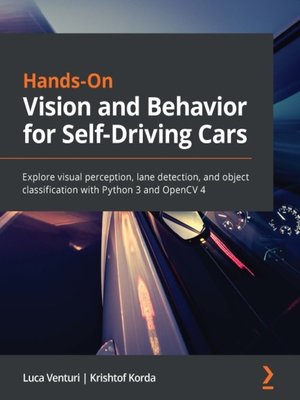Hands-On Vision and Behavior for Self-Driving Cars
ebook ∣ Explore visual perception, lane detection, and object classification with Python 3 and OpenCV 4
By Luca Venturi

Sign up to save your library
With an OverDrive account, you can save your favorite libraries for at-a-glance information about availability. Find out more about OverDrive accounts.
Find this title in Libby, the library reading app by OverDrive.



Search for a digital library with this title
Title found at these libraries:
| Library Name | Distance |
|---|---|
| Loading... |
A practical guide to learning visual perception for self-driving cars for computer vision and autonomous system engineers
Key FeaturesThe visual perception capabilities of a self-driving car are powered by computer vision. The work relating to self-driving cars can be broadly classified into three components - robotics, computer vision, and machine learning. This book provides existing computer vision engineers and developers with the unique opportunity to be associated with this booming field.
You will learn about computer vision, deep learning, and depth perception applied to driverless cars. The book provides a structured and thorough introduction, as making a real self-driving car is a huge cross-functional effort. As you progress, you will cover relevant cases with working code, before going on to understand how to use OpenCV, TensorFlow and Keras to analyze video streaming from car cameras. Later, you will learn how to interpret and make the most of lidars (light detection and ranging) to identify obstacles and localize your position. You'll even be able to tackle core challenges in self-driving cars such as finding lanes, detecting pedestrian and crossing lights, performing semantic segmentation, and writing a PID controller.
By the end of this book, you'll be equipped with the skills you need to write code for a self-driving car running in a driverless car simulator, and be able to tackle various challenges faced by autonomous car engineers.
What you will learnThis book is for software engineers who are interested in learning about technologies that drive the autonomous car revolution. Although basic knowledge of computer vision and Python programming is required, prior knowledge of advanced deep learning and how to use sensors (lidar) is not needed.







